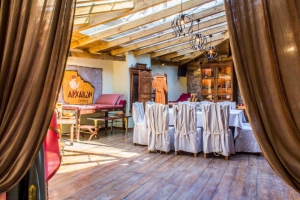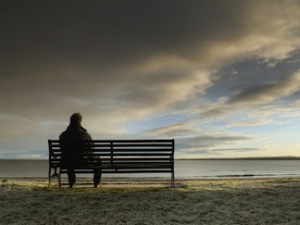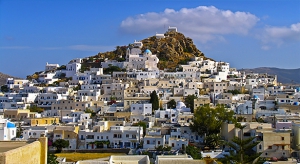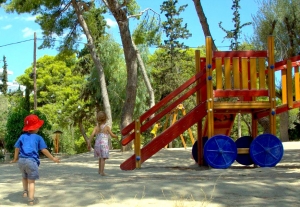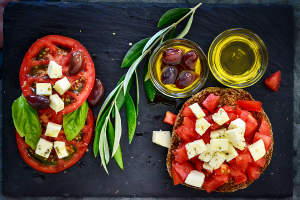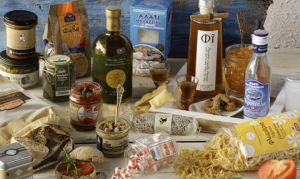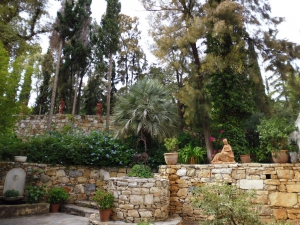BUSINESS CENTRE
XpatAthens
Monday, 18 May 2015 07:00
Ancient Greek Cuisine Revives In Psyri District In Athens
Archeon Gefsis, an Ancient Greek-style restaurant located on 6 Agion Anargiron Street in the Psyri District in Athens, recently opened its doors. This themed restaurant, which translates to Ancient Tastes, is renowned for its unique style and atmosphere and aims to offer guests a brand new culinary experience.
Backed by a team that includes specialized architects, taste specialists and researchers of ancient writings, Archeon Gefsis focuses on the revival of the cuisine of Ancient Greece and aims to initiate food lovers into the healthy nutritional and dietary habits of the sophisticated men who led the way to our civilized society.
The restaurant offers a very interesting combination of recipes and flavors that are based on ancient ingredients. With the addition of traditional wines and along with the mystagogic atmosphere of antiquity, guests will feel as if they have suddenly been transferred to Ancient Greece and are about to dine with Socrates, Platon and Pericles.
All dishes are prepared strictly on the basis of ancient recipes of the 5th, 4th and 3rd Centuries BC, adapted to suit contemporary tastes. The menu is written with detail and contains authentic ingredients and cooking methods extracted from the ancient books from which recipes were derived.
To read more, please visit: Greek Travel Pages
Published in
Restaurants In Athens
Tagged under
Friday, 15 May 2015 16:40
Serendipity Magazine - 4th Issue
Serendipity Magazine explores how artists express through their spirit in this issue. This issue, a fourth in a series exploring The Anatomy of the Artist, features painters, writers, photographers and a tasty bit more!
Click the following link to read this issue of the magazine: http://free.yudu.com/item/details/3154087/Anatomy-of-the-Artist---Art-of-the-Spirit.
Click the following link to read this issue of the magazine: http://free.yudu.com/item/details/3154087/Anatomy-of-the-Artist---Art-of-the-Spirit.
Published in
Greek Language & Culture
Tagged under
Thursday, 14 May 2015 21:01
Overcoming Loneliness The 'OPA!' Way
Despite connecting with new "friends" via online social networking (e.g., Facebook), despite living in cities with thousands of people, and despite working in large organizations, the incidence of people who say they are lonely keeps rising. Many people are connecting all the time -- working two jobs, using Blackberries, iPhones and other devices 24/7, engaging in numerous activities -- yet they still feel that they have no one with whom to talk about serious issues in their lives, no one to talk things out. It's becoming a big issue in our society and postmodern world.
A recent AARP study, for instance, found that the percentage of Americans who have no one with whom to discuss important matters has risen to more than 24 percent (that's right, essentially one out of every four people!). They also found that the loneliest people were in their mid-years, not the older folks who are typically thought to be the loneliest in our society.
It's time for what the Greeks call an antidoto (αντίδοτο), which translates into the familiar English word, "antidote," meaning a remedy or something that relieves or prevents a situation. It's time to return to the OPA! Village where connecting meaningfully with Others is a daily priority.
In the village, it is customary to find men sitting in kafenios (cafés) talking and connecting with each other in the early mornings before the day's chores begin and again in the late afternoons after the day's chores have been completed. We also find young men taking walks with other young men with their babies in strollers in the early evening. We find community tables in restaurants where people truly bond over food, taking the time to share a meal such as dinner together and discuss life while eating from shared platters of food.
This is in sharp contrast to what is experienced in our North American society, where we typically eat at separate tables with individual plates of food, or rush through our meal at a "fast food restaurant," or even purchase "takeout food" that we take home to eat, often sitting alone in our homes. Importantly, we would like to point out that the Greek word for "banquet" is συμπόσιον, which is the English word "symposium," even though its contemporary meaning and practical uses have obviously changed over the years. To the Greeks, both in ancient times and today, the idea of connecting with others over food (and drink) is the true essence of the symposium, which is not treated lightly and, in point of fact, is a very important part of daily life.
Insight: Socializing is important to our health, not just in physical sense but also in terms of our emotional and spiritual well-being. Research has shown that bonding and having friends lowers our blood pressure and stress levels and also strengthens our immune systems, leading to longer, healthier lives! So go beyond social networking online -- reach out to truly find ways to bond with others. Let's bring back the traditional notion of the "symposium." This is an essential part of living (and working) The OPA! Way! Opa!
Dr. Alex Pattakos and his partner, Dr. Elaine Dundon, are the co-founders of The OPA! Way® lifestyle of "Living Your Inner Greece!" which means living all of life to the fullest with enthusiasm and meaning. You can find out more about Dr. Pattakos, author of the international bestselling book "Prisoners of Our Thoughts," and Dr. Dundon, author of the international bestselling book, "The Seeds of Innovation," in their HuffPost bio. You are also invited to follow The OPA! Way on Twitter (www.twitter.com/TheOPAWay) and join the OPA! Village (www.theopaway.com).
By Alex Pattakos
Published in
Books
Tagged under
Friday, 15 May 2015 07:00
Seven Greek Isles Among Mediterranean’s Top 10, Ios Leads The Way
The hotels on seven Greek islands are luring visitors to Greece as revealed by online booking agent Trivago UK’s annual Mediterranean Island Reputation Ranking 2015 released recently, placing the Cycladic isle of Ios on the top of the list.
Ios with 86.22 percent, Hydra at 88.11 percent and Folegandros at 85.03 percent lead the way with the best-rated hotels in the Mediterranean. Destinations that follow are Italy’s Capri with 84.95 percent, Santorini at 84.66 percent, Mykonos with 84.38 percent, Naxos with 84.33 percent, Paros at 84.31 percent, Lipari in Italy with 84.18 percent and Portugal’s Madeira at 83.76 percent.
The index ranks Mediterranean islands according to the reputation of their hotels, based on over 140 million reviews and ratings aggregated from over 200 booking sites worldwide between April 1 and September 30, 2014. Included in the list are islands with at least 50 hotels and hotels with at least 50 reviews.
To read more, please visit: Greek Travel Pages
Published in
Local News
Tagged under
Wednesday, 05 September 2018 07:00
Best Parks For Kids In Central Athens
There are many excellent outdoor areas to enjoy in and around Athens. This list is an excellent resource for finding the best child-friendly parks!
National Park Playground
This playground is located within the National Park of Athens. The big trees of the park shadows the playground providing a safe heaven for children during those sunny days. The park is located in the center of Athens, nearby Syntagma Square.
Zappio Playground
Zappio playground has a big jumper mast net for children and a wooden structure with climbing ladders, ropes, and slides. The playground is a few minutes by foot from the Panathenaic Stadium and the National Garden.
Thisio Playground
Thisio playground is located on Apostolou Pavlou pedestrian street. Although it is quite small, this playground has a view of the Acropolis. If you walk further up Apostolou Pavlou Street from the Thisio Metro Station, you will reach the main entrance to the Acropolis and the Acropolis Museum.
Volta Fun Park - Faliro
This is one of the Flisvo Marina attractions in Palio Faliro. There is an entrance fee of 5 euros for the inflatable castles. The children's access to the playground area is controlled, so you can sit calmly and enjoy a coffee while your kids are playing. The Fun Park also contains an artificial pond with small swan boats, a trampoline area, and a small track with electrical toy cars.
Marina Flisvo
Marina Flisvo is ideal for the weekend. The marina, complete with luxurious boats and yachts, coffee shops and restaurants, makes this place a pleasant destination for both parents and children.
To read this article in full, please visit: AthensFever
Published in
Kids Life
Tagged under
Tuesday, 27 November 2018 07:00
How To Eat Like A Greek In 3 Steps
We know that the Mediterranean diet is considered one of the healthiest, if not the healthiest diet in the world.
The culinary habits of Greece and southern Italy offer numerous health benefits from heart protection to mental health.
This diet is based on simple ingredients such as olive oil, vegetables, fruit, beans, yogurt, cheese, some fish, a bit of meat and plenty of herbs. And while these ingredients may sound simple, they are nutritionally complex, full of antioxidants, substances that protect the body from various chronic diseases.
Anyone can make their diet more Mediterranean by using mostly olive oil for their cooking needs, eating plenty of seasonal fruit and vegetables and eating less meat. Here are simple steps to get you started:
Make Greek Style Open Sandwiches
In Greece partucularly in Crete a popular dish is the Dakos, a whole grain barley rusk (paximadi) topped with soft white cheese, tomatoes, olives and drizzled with olive oil. You can make your own by substituting a thick piece of toasted whole wheat bread. Top first with tomatoes, than crumbled feta cheese, a few olives, add some olive oil and a sprinkle of dry oregano.
Eat Vegetables as a Main Course
Greeks have the highest consumption vegetables in the world according to a latest study from the Tufts University. How do they do this? The answer is vegetable casseroles. Greeks consume so many vegetables because they serve them as a main course. Use fresh or frozen vegetables; almost anything will do, but the best are green beans, peas, okra and cauliflower. Sauté a chopped onion in 4 tablespoons of olive oil, add about 500 grams of vegetables and continue sautéing. Next, add about 250 grams of crushed tomatoes, a bit of parsley, salt and pepper, and some water, enough so that it halfway covers the vegetables. Let it simmer for about an hour. Serve with a slice of fresh bread and feta cheese.
To read more, please visit: The Food and Leisure International Guide
Published in
Greek Food & Diet
Tagged under
Thursday, 14 May 2015 07:00
Greek Tourism Expo Takes Two, Explores Leisure, MICE Travel
Leisure and MICE tourism will be the focus of the 2nd Greek Tourism Expo to take place at the Athens Metropolitan Expo on 4-6 December, when sector professionals come together to discuss challenges, offer solutions and forge ties for the most effective promotion of the Greek tourist product.
Organised by LeaderExpo, the three-day event offers a platform of exchange for professional bodies, municipal authorities, entrepreneurs, tour operators and tourist agents as well as cruise companies, managers and marketing experts.
For more information, please visit Greek Travel Pages
Published in
Greece In The News
Tagged under
Wednesday, 13 May 2015 07:00
You've Met A Greek Mother If You've Heard These Phrases
Have you ever met a Greek mother? It was Mother’s Day recently and maybe you visited Greece or plan to, or you may have Greek friends around the world, or maybe your roommate is a Greek. Next time you hear these phrases from their Greek mothers, it is good to know what they mean.
What a Greek Mother will say and what it means
- Keep your eyes fourteen! (Means: be cautious).
- The feet revolted and want to hit the head (Means: denouncing authority).
- I ate the whole world to find you (Means: I looked everywhere).
- That’s just a small chandelier (Means: It’s not that big a deal).
- If that is true you can pierce my nose (Means: No way that is true).
- She/He will fit your two legs in 1 shoe (Means: She/He will do with you as he/she pleases or/and push you around).
- The lid rolled and found the kettle (Means: These people are the same or/and think the same way, one fits on the other).
- I got fleas in my ears (Means: I am suspicious for something I am thinking or have heard. By the way, it’s origin is from an actual torture in Byzantine times).
- She/He will cook the fish on your lips (Means: She/He will torture you with nagging or other psychological way).
- She/He will change your lights (Means: Same as above. The actual origin of this phrase comes too from an actual torture).
- Though we haven’t seen him yet, we call him Yiannis (Means: We still don’t know what/who is, yet we have labeled him with something. The origin comes from an anecdote with Kolokotronis and Nikitaras at the Greek revolution of 1821).
Common phrases a Greek Mother will use to “work you around”
(Some are used by Greek fathers too)
- If you or your brother want to kill each other, get out. I just finished cleaning the floor.
- Pray the carpet stain can be removed.
- I am going to get your semester grades. If they are not good you better leave the house and not find you when I come back.
- What do you mean “why?”. Because, I said so!
- If you fall and bleed your knees, you will get spanked because you would have ripped your trouser too!
- Change your underpants! Suppose you have an accident and end up to the hospital. What would doctors say.
- Stop crying without a reason, or I will give you a reason to cry.
- Sure, that is a nice shower you had. Can’t you see that the back of your neck is still black/dirty?
- Close your mouth and eat your lunch.
- Your room is like being hit by a hurricane.
To read more, please visit: A Greek Adventure
Published in
Greek Language & Culture
Tagged under
Wednesday, 13 May 2015 07:00
Local Food Lovers Have Three Big Treats Coming Up
Greek food is taking center stage at a number of unlikely locations around Athens this month. Over 500 Greek producers, prominent chefs, restaurateurs, hotel owners, wine professionals and food specialists are participating in three large-scale gastronomy festivals taking place at the Technopolis cultural complex in Gazi, Stadio Irinis kai Filias (Peace and Friendship Stadium) in Neo Faliro and the Benaki Museum’s Pireos Street annex.
The past few years have seen local foodies moving away from international trends and focusing more on Greek flavors, products and small producers. Is this a form of roots revival, a patriotic effort to support local producers, a healthy rethink of traditional dishes, or even a kind of introversion during this difficult period? Possibly a combination of all of the above, but the fact that it leads to the development of local culinary culture is certainly a key positive point.
Following four highly successful events, “Greece, Celebration, Flavors” a festival organized by Athens city guide Athinorama and its food-focused sibling Athinorama Umami, has become quite an institution. Featuring 130 Greek producers, this year’s event starts today and runs through Sunday at Technopolis. The parade of Greek products will be complemented by a number of culinary and cultural events, concerts and visual art activities. During the course of the festival, the products on display will also be on sale, allowing visitors to sample the goods at their own leisure.
On the same days, the Peace and Friendship Stadium turns into a culinary arena and open-air market. The first edition of the Athens Food Festival will host over 200 small producers from around Greece presenting more than 500 types of traditional local products, recipes and culinary secrets from across the country, while noted Greek chefs and food specialists will also take part in presentations.
The festival’s program is based on four core themes: culinary presentations, product display, tastings and conferences. The event’s agenda includes an exhibition of high-quality products from small Greek producers, such as cheese, wine, honey and flour, as well as workshops and demonstrations of production methods used in rural parts of the country. A traditional olive press – billed as the largest ever to be erected at a trade show – will be used for the in situ production of virgin olive oil from a selection of Greek varieties, including the Koroneiki, Manaki and Ladoelia, among others.To read more, please visit ekathimerini
by Yiouli Eptakili
Published in
Local News
Tagged under
Tuesday, 12 May 2015 07:00
The Vorres Museum - A Garden Paradise
Located in six acres of lush gardens in Paiania, near Athens Airport, the Vorres Museum was founded in 1983 by Ian Vorres in order to promote Greek art and culture through a diverse range of activities, exhibitions and children’s activities. A graduate of Athens College, Mr Vorres was a famous Greek art collector who studied Economics and Political Science at Queen’s University in Ontario, Canada and furthered his studies with a Diploma in Philosophy and Psychology from the University of Toronto. After a career in Journalism in Canada, Between 1991-1998 Mr. Vorres served as Mayor of Paiania – the area of Athens where the Museum is located. He passed away in February 2015.
Divided into two sections: Contemporary and Folk Art, both museums showcase over 2,500 years of Greek history. I have had the fortunate experience of visiting Vorres twice now – once when I experienced St. Thomas’s B&B in nearby Paiania, the second time in October 2014 when TBEX hosted its European conference in Athens, they held their Speakers Party in the gardens.
Whilst the museums are interesting, I couldn’t stop marvelling at how peaceful the gardens were and could happily sit for hours. My second time I spent more time being shown the Folk and Contemporary Art. Both are fascinating and the art space is housed in a warehouse style building – but the aesthetics work well and are in keeping with the surroundings. Exhibitions are changed according to which artist is in residence.
Rental
It's possible to rent the space out and I’ve been told by friends that Vorres makes a fantastic location for a wedding. With the ability to host up to 700 people, with its gardens and location under Mount Imittos, I would certainly consider holding an event here! Check out their events page for more information.
Published in
City Discovery
Tagged under


